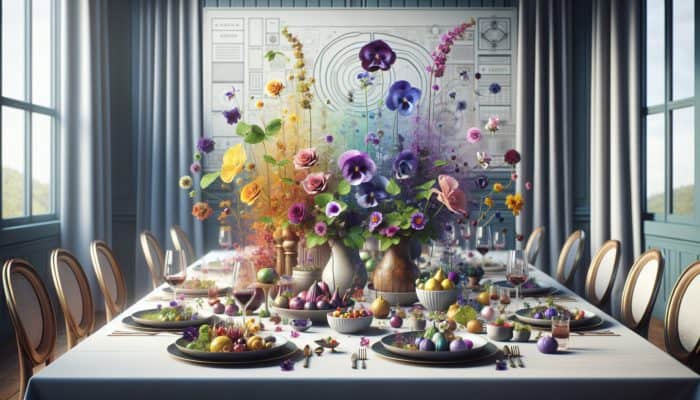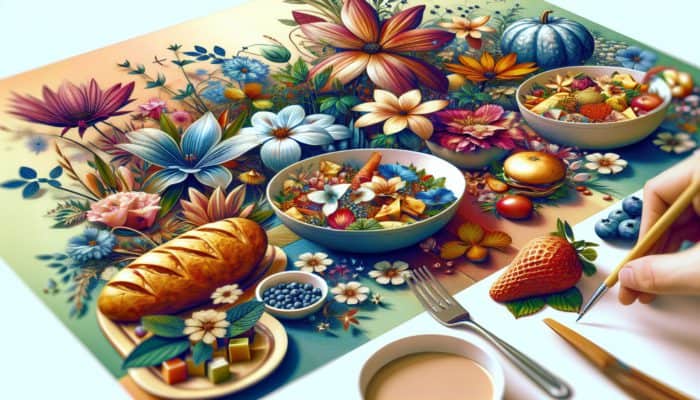Enhance Your Dishes with Stunning Edible Flower Garnishes
Understanding Edible Flowers and Their Role in Culinary Excellence

Exploring the incorporation of edible flowers into your culinary repertoire can drastically redefine how you present food. These exquisite blossoms are entirely safe to consume and significantly enhance the flavour and visual allure of a diverse range of dishes. By integrating these colourful blooms into your meals, you not only introduce a spectacular splash of colour but also a fascinating texture and occasionally surprising flavours that elevate the dining experience. Beyond mere decoration, edible flowers activate various senses, enriching the overall enjoyment of the meal. With a vast selection of blossoms available, both expert chefs and passionate home cooks can creatively incorporate edible flowers into their dishes, transforming simple recipes into extraordinary creations that are sure to captivate any guest.
The tradition of using flowers in cooking is steeped in history across countless cultures globally. For instance, aromatic rose petals are a staple in traditional Persian cuisine, while the vibrant hues of nasturtiums embellish contemporary Australian salads. Edible flowers provide a rich spectrum of flavours and colours, showcasing their versatility as garnishes for salads, desserts, and beverages alike, thereby fostering an environment for creative culinary expression. Moreover, the visual beauty of these flowers significantly enhances food presentation, transforming each dish into not just a treat for the taste buds but also a feast for the eyes.
Discover the Most Popular Edible Flower Varieties to Enrich Your Dishes
Venturing into the realm of edible flowers unveils an impressive array of options that can broaden your culinary landscape. Some of the most sought-after varieties include roses, prized for their sweet scent and delicate flavour; violets, which introduce a gentle sweetness; and nasturtiums, known for their peppery zest reminiscent of arugula. Each flower contributes its distinct flavour profile and visual appeal, empowering chefs to innovate and craft dishes that are as visually stunning as they are delightful to eat.
Other noteworthy edible flowers comprise chamomile, which offers an apple-like flavour perfect for enhancing teas and desserts, and lavender, renowned for its aromatic qualities that enrich both sweet and savoury dishes. Hibiscus flowers are often brewed into refreshing beverages, while borage adds a cucumber-like taste and striking blue hue to salads. Understanding the unique characteristics of each edible flower is essential, as their selection can dramatically influence the flavour profile of a dish, thereby enhancing the overall dining experience.
Ensuring the Safety of Edible Flowers in Your Culinary Adventures
Identifying which flowers are safe for consumption is crucial for both culinary success and safety. This process begins with comprehending the plant’s origins, potential toxins, and employing accurate identification techniques. It is imperative to source edible flowers from reputable suppliers or cultivate them organically at home, ensuring they are free from harmful pesticides and chemicals, thereby guaranteeing safety in your culinary adventures.
When identifying safe edible flowers, certain key characteristics can guide your choices. Brightly coloured blooms often indicate safety, while dull or greyish flowers may pose risks. For instance, flowers such as marigolds and calendula are non-toxic and entirely safe to consume, whereas others, like foxglove or daffodils, are poisonous and should be completely avoided. Familiarising yourself with reliable resources, including identification books and local plant workshops, can significantly enhance your ability to make informed decisions when selecting edible flowers for your culinary creations.
Maximising Visual Impact: Techniques for Using Edible Flowers as Garnishes

Employing edible flowers to elevate the visual appeal of your dishes involves several strategies, such as careful placement, pairing with complementary ingredients, and ensuring their freshness. When garnishing, it’s vital to consider both colour contrast and the size of the flowers in relation to your dish. For example, larger, bold flowers can serve as striking focal points, while smaller blossoms can be delicately sprinkled to provide a refined touch.
Complementing edible flowers with suitable flavours can amplify their impact on the dish. For instance, the peppery notes of nasturtiums beautifully complement creamy dressings, while sweet violets can elevate desserts to new heights. To maintain the freshness of the flowers, add them just before serving, ensuring they appear vibrant and inviting. Proper storage in a cool environment is also essential for preserving their quality. Remember, presentation plays a key role; a beautifully arranged plate not only pleases the eye but enhances the entire dining experience, making it memorable for all involved.
Uncover the Health Benefits of Incorporating Edible Flowers
Delving into the nutritional advantages of edible flowers reveals that they are not just decorative; they also provide substantial contributions to a healthy diet. Many of these blossoms are rich in antioxidants, vitamins, and minerals, offering health benefits that extend beyond aesthetics. For instance, chamomile flowers are lauded for their calming properties, while dandelions are abundant in essential vitamins A, C, and K. By incorporating these flowers into your meals, you can significantly enhance your overall nutrition and well-being.
However, it’s vital to remain cognizant of potential allergies or dietary restrictions. Some individuals may react to specific flowers, so conducting a patch test before trying new varieties is prudent. Additionally, moderation is essential; enjoying edible flowers in appropriate quantities allows one to reap their benefits without adverse effects. Ultimately, integrating edible flowers into your diet presents a unique fusion of flavour and nutrition, making them a delightful addition to any meal.
Essential Guidelines for Mastering Edible Flower Garnishes
Criteria for Culinary Professionals When Selecting Edible Flowers

Culinary professionals carefully select edible flowers based on numerous criteria, including their flavour, aesthetic appeal, and safety. They consider the culinary context of the dish and the desired sensory experience when making their selections. For example, a chef might choose nasturtiums for their peppery flavour to pair with a gourmet salad, while lavender may be selected for desserts to provide a soothing aroma and floral note. This meticulous selection process is crucial for crafting dishes that tantalise the taste buds and create a harmonious dining experience.
Real-life examples abound in upscale dining venues, where chefs curate their floral selections to enhance their menus. For instance, in a contemporary fusion dish, a chef may pair microgreens with edible pansies, adding both texture and colour. Furthermore, considering the seasonal availability of flowers is essential; in-season blooms typically yield superior flavour and are often more sustainable and cost-effective. Ultimately, the thoughtful selection of edible flowers plays a pivotal role in the success of a dish, ensuring diners have a delightful experience.
Best Practices for Incorporating Edible Flowers into Your Culinary Creations
Utilising best practices for employing edible flowers includes meticulous cleaning, proper storage, and pairing with dishes. It’s crucial to ensure that the flowers are free from pesticides and harvested at the right time to maintain their quality. When preparing edible flowers, gently rinse them under cool water to eliminate any dirt or insects, avoiding soaking them, as this could cause the flowers to absorb excess water and compromise their structural integrity.
Storage is equally important for preserving quality; wrapping flowers in a damp paper towel and placing them in an airtight container in the refrigerator can help retain their freshness for several days. When pairing flowers with dishes, it’s crucial to consider their flavour profiles for optimal results. For example, rose petals beautifully enhance desserts, while chive blossoms can elevate savoury creations. Providing actionable steps for integrating edible flowers into your cooking not only maximises their culinary potential but also fosters creativity and experimentation in the kitchen.
Where to Find Premium Edible Flowers for Your Culinary Needs
Acquiring high-quality edible flowers can be achieved through specialty markets, online suppliers, or by cultivating them in your own garden. Ensuring these flowers are organic and free from harmful chemicals is paramount for both safety and flavour. Specialty markets often boast a diverse selection of fresh edible flowers, while online suppliers may offer unique varieties that are not readily available locally. Growing your own flowers at home is an excellent way to guarantee quality and freshness, allowing for experimentation with various types.
Experts recommend seeking suppliers that specialise in organic produce when sourcing edible flowers. Checking for certifications and reading customer reviews can aid you in selecting reputable sources. Additionally, local farmers' markets often feature vendors who cultivate edible flowers, providing an opportunity to inquire about their growing practices. By sourcing your flowers thoughtfully and responsibly, you can elevate your culinary experience while supporting sustainable agricultural practices.
Innovative Techniques for Using Edible Flower Garnishes Creatively
Transform Your Salads with Edible Flowers for Striking Visual Presentation
Enhancing the visual charm of salads by incorporating edible flowers is an outstanding method to elevate a simple dish into something extraordinary. Flowers can be artfully sprinkled over the salad or arranged in intricate designs that draw the eye. The interplay of colours and textures adds a new dimension to salads, making them more inviting and appetising. Beyond their aesthetic contributions, edible flowers can also introduce unique flavours that harmonise beautifully with other ingredients.
The advantages of incorporating flowers into salads are numerous, including:
- Enhanced visual presentation, making the dish considerably more attractive.
- Introduction of new flavours that elevate the overall taste profile.
- Increased nutritional value, enriching the dish with essential vitamins and antioxidants.
- Seasonal variety allows for creative expression and adaptability in meal preparation.
Integrating edible flowers such as pansies, nasturtiums, and dandelions can result in vibrant salads that not only please the palate but also delight the eye. Experimenting with different combinations of flowers inspires creativity, leading to signature salads that reflect individual styles and flavour preferences.
Infusing Beverages with Edible Flowers for a Unique Twist
Elevating beverages by infusing them with edible flowers creates a memorable and sophisticated drinking experience. This technique can be applied to teas, cocktails, and even water for a refreshing twist. For instance, hibiscus flowers can be steeped in hot water to produce a tangy and vibrant tea, while lavender can be infused into simple syrups for cocktails. These floral infusions not only enhance the flavour but also add a visually striking element, transforming everyday drinks into extraordinary concoctions.
Some of the best flowers for various beverages include:
- Lavender is prized for its aromatic properties in cocktails and teas.
- Hibiscus offers a tangy and refreshing kick in drinks.
- Rose petals contribute a fragrant note to cocktails.
- Borage imparts a cucumber-like taste that enhances summer beverages.
By understanding the unique characteristics of each flower, one can create harmonious flavour profiles in drinks. Infusing beverages with edible flowers not only provides visual pleasure but also encourages creativity through various flavour combinations, resulting in unique and delightful drinking experiences that captivate the senses.
Baking with Edible Flowers for Distinctive Flavours and Presentation
Incorporating edible flowers into baked goods yields exceptional and visually striking outcomes, making desserts as appealing as they are delicious. Flowers can be added to cakes, cookies, and pastries, contributing both flavour and decorative beauty. For example, adding violets to a vanilla cake can introduce a subtle floral note, while chamomile can be woven into shortbread cookies for a delightful twist that surprises the palate.
To preserve the colour and flavour of flowers during baking, it's crucial to consider the timing and method of incorporation. Adding flowers towards the end of the baking process or using them as a topping after cooling can help maintain their vibrant hues. Additionally, bakers may need to adjust baking times to achieve the desired results without compromising the integrity of the flowers. Experimenting with different flower varieties encourages bakers to create signature recipes that burst with creativity and flavour, transforming desserts into true works of art.
Exploring the Health Benefits of Edible Flower Garnishes
Understanding the Nutritional Value of Edible Flowers
Many edible flowers are teeming with essential vitamins, minerals, and antioxidants, making them a significant enhancement to a balanced diet. For instance, nasturtiums are rich in vitamin C, while marigolds provide carotenoids that support skin health. Consuming these flowers not only enhances the flavour and visual appeal of dishes but also positively contributes to overall nutrition and wellness.
Incorporating edible flowers into your meals can offer various health benefits, such as boosting the immune system, aiding digestion, and reducing inflammation. Additionally, flowers like dandelions are acclaimed for their detoxifying properties, benefiting liver health. By adding these nutrient-dense blossoms to daily meals, individuals can enrich their diets while enjoying the culinary creativity that edible flowers bring.
Medicinal Benefits of Edible Flowers: A Closer Look
Some edible flowers have been utilised for centuries for their medicinal properties, showcasing their value beyond mere decoration. These flowers can support digestion, reduce inflammation, and promote overall wellness. For instance, chamomile is well-known for its calming effects, making it a popular choice for alleviating anxiety and enhancing sleep quality. Similarly, lavender is recognised for its ability to reduce stress and improve mood, making it a staple in many herbal remedies.
Key medicinal benefits associated with edible flowers include:
- Chamomile for its calming effects and digestive aid.
- Hibiscus for its ability to lower blood pressure and promote heart health.
- Echinacea for its role in boosting the immune system.
- Lavender for its stress-reducing properties and promotion of relaxation.
By incorporating these flowers into daily diets, individuals can experience holistic health benefits that align culinary enjoyment with wellness goals. As awareness of the medicinal properties of edible flowers continues to grow, their use in both cooking and herbal remedies flourishes, enriching lives on multiple levels.
Maximising the Health Benefits of Edible Flowers in Your Diet
To fully enjoy the health benefits of edible flowers, it is advisable to consume them fresh and in moderation. Fresh flowers generally retain more nutrients and flavour, making them ideal for garnishing and enhancing dishes. Pairing them with other nutritious foods can amplify their health benefits; for example, adding rose petals to a smoothie not only enhances its visual appeal but also provides additional vitamins and antioxidants.
Incorporating edible flowers into salads, beverages, and desserts allows for creative combinations that promote health and wellness. It is prudent to research specific flowers to understand their unique benefits and any potential interactions with medications. By consciously including edible flowers in your meals, you can enjoy both the culinary and health advantages they offer, leading to a vibrant and wholesome diet filled with flavour and beauty.
Proven Strategies for Creating Exceptional Edible Flower Garnishes
Optimal Storage Techniques for Edible Flowers to Preserve Freshness
Effective storage methods are vital for maintaining the freshness and flavour of edible flowers. Techniques such as refrigeration, freezing, and drying can help preserve their quality for extended periods. For short-term storage, placing flowers in a damp paper towel and storing them in an airtight container in the refrigerator can keep them fresh for several days, preventing wilting and ensuring they remain visually appealing.
For long-term storage, freezing edible flowers is an efficient choice. Gently washing and drying the flowers, then placing them in ice cube trays filled with water or syrup, preserves their colour while creating beautiful ice cubes for drinks. Drying flowers is another viable option; this can be accomplished by hanging them upside down in a cool, dark area. Once dried, they can be stored in airtight containers for use in teas or as flavourful enhancements in baked goods.
Essential Preparation Steps for Edible Flowers Prior to Culinary Use
Preparing edible flowers involves several essential steps to ensure they are safe and ready for consumption. Begin by gently rinsing the flowers under cool water to remove any dirt or insects, taking care to avoid soaking them, as this can damage their delicate structures. After rinsing, it’s important to remove any stamens and pistils, as these can impart bitterness or may trigger allergic reactions.
Cutting the flowers to the desired size is critical for effective presentation; larger blooms can be left whole for a dramatic effect, while smaller flowers can be artfully scattered throughout the dish for elegance. Some edible flowers, such as dandelions, may require additional preparation, including blanching or the removal of bitter parts. By dedicating time to prepare flowers properly, you can enhance both the visual appeal and flavour of your culinary creations, making them even more enjoyable.
Pairing Edible Flowers with Diverse Culinary Styles for Optimal Results
Edible flowers can complement a wide range of cuisines, from savoury to sweet, making them incredibly versatile in culinary applications. Understanding flavour profiles is crucial for creating appropriate pairings. For instance, rose petals beautifully enhance Middle Eastern dishes, imparting a fragrant touch to rice dishes and desserts, while chive blossoms can elevate the flavours of creamy dips and salads.
Pairing edible flowers with different dishes involves recognising their unique attributes. Nasturtiums, for example, are perfect for salads, offering a peppery bite that adds depth and character. In contrast, lavender can elevate pastries and desserts, creating a soothing aroma that pairs well with sweet flavours. Through experimentation with various combinations, one can discover exciting and unexpected pairings that enhance the overall culinary experience, making meals truly memorable.
Choosing the Most Suitable Edible Flowers for Beautiful Garnishing
Selecting edible flowers based on their colour, flavour, and texture is essential for creating stunning garnishes that enhance dishes. When choosing flowers for garnish, it’s crucial to consider the colour scheme of the dish. Bright, vibrant flowers like pansies or marigolds can create a striking visual impact against a neutral backdrop. Flavour considerations are equally significant; opting for flowers like chive blossoms or nasturtiums can introduce complementary tastes that elevate the overall dish.
Understanding which flowers are most suitable for different types of garnishes is crucial for effective presentation. For example, larger blooms can serve effectively as focal points in centrepieces, while smaller flowers can be artfully scattered for an elegant touch. Selecting the right flowers involves balancing aesthetics with flavour, ultimately resulting in beautifully garnished plates that delight both the eye and the palate, enhancing the overall dining experience.
Current Trends and Innovations in Edible Flower Garnishing
Emerging Trends in the Culinary Use of Edible Flowers
Keeping abreast of the latest trends in the culinary application of edible flowers reveals a dynamic landscape of creativity and innovation. Both chefs and home cooks are experimenting with novel flavour combinations and presentation techniques that challenge traditional cooking methods. For instance, the trend of incorporating flowers into cocktails has gained momentum, with bartenders using blooms like elderflower and hibiscus to craft unique, visually captivating drinks that impress patrons.
Furthermore, the popularity of floral-infused desserts is on the rise. Chefs are creatively blending floral flavours with classic sweets, resulting in desserts that boast both exquisite taste and breathtaking presentations. The use of edible flowers in savoury dishes is also gaining traction, as chefs explore unexpected combinations that defy conventional culinary norms. As the movement towards local sourcing and sustainability continues to grow, more chefs are cultivating their own edible flowers, ensuring the highest freshness and quality in their offerings.
Innovative Products Featuring Edible Flowers on the Market
A variety of innovative products featuring edible flowers has emerged, offering convenient methods to incorporate floral elements into culinary creations. Examples include flavoured salts infused with lavender and syrups made from hibiscus, providing chefs and home cooks with simple solutions for enhancing flavour profiles. Edible flower-infused oils are also becoming popular, allowing for a splash of floral essence in dressings, marinades, and sauces.
These products not only simplify the integration of edible flowers into meals but also open exciting new avenues for culinary creativity. For example, a drizzle of lavender-infused oil can elevate a dish, introducing aromatic notes that beautifully complement a variety of flavour profiles. The trend toward artisanal edible flower products is likely to continue, providing enticing options for those looking to enhance their culinary repertoire with unique and delicious flavours.
How Chefs Are Innovating with Edible Flowers in Their Dishes
Chefs are continually pushing the boundaries with edible flowers, exploring innovative techniques and unexpected flavour pairings. The emergence of molecular gastronomy has enabled chefs to experiment with textures and presentations, incorporating flowers in novel forms such as gels, foams, and powders. These techniques showcase the aesthetic potential of edible flowers while highlighting their versatility in modern cuisine.
Fusion cuisine represents another exciting realm where edible flowers are gaining prominence. Chefs creatively combine traditional dishes with floral elements from various cultures, resulting in thrilling new flavour profiles. For instance, a classic Italian risotto could be elevated with borage flowers, adding a refreshing twist that surprises and delights the palate. As culinary boundaries continue to blur, chefs are embracing edible flowers as key ingredients, transforming their approach to flavour and presentation in their culinary creations.
Frequently Asked Questions About Edible Flowers in Culinary Use
Considerations for Using Edible Flowers in Your Cooking
When incorporating edible flowers into your culinary repertoire, consider their flavour, potential allergens, and whether they have been treated with pesticides. Always source flowers from reputable suppliers or cultivate them organically at home to ensure safety.
Is It Safe to Consume Flowers from My Garden?
Not all flowers in gardens are safe for consumption. It’s essential to accurately identify any flowers you plan to consume and confirm their edibility beforehand. It’s best to only eat flowers that are known to be safe and free from chemicals or pesticides.
How Can I Integrate Edible Flowers into My Dishes?
Edible flowers can be utilised in salads, beverages, desserts, and as garnishes. Experimenting with different types allows you to discover pairings that beautifully complement your dishes, enhancing both flavour and visual appeal.
Are There Safety Concerns Associated with Edible Flowers?
Yes, certain flowers can be toxic or trigger allergic reactions. Always ensure that the flowers you use are safe for consumption and sourced from trusted suppliers to avoid any health risks.
What Are Some Common Edible Flowers to Consider?
Common varieties of edible flowers include roses, violets, nasturtiums, lavender, and hibiscus. Each of these flowers offers unique flavours and visual appeal, making them excellent choices for enhancing various dishes.
How Should I Properly Store Edible Flowers?
To store edible flowers effectively, wrap them in a damp paper towel and place them in an airtight container in the refrigerator. This method helps maintain their freshness for several days, allowing you to enjoy their beauty and flavour.
Is It Possible to Use Dried Edible Flowers in Cooking?
Yes, dried edible flowers can be incorporated into culinary creations, but they may have a more concentrated flavour. They work well in teas, infusions, or as flavour enhancers in baked goods.
What Health Benefits Do Edible Flowers Provide?
Many edible flowers are rich in essential vitamins, minerals, and antioxidants. They can aid digestion, boost the immune system, and offer anti-inflammatory properties, contributing positively to overall health.
How Should I Prepare Edible Flowers for Cooking?
To prepare edible flowers for culinary use, gently rinse them to remove dirt, remove any inedible parts like stamens, and cut them to the desired size for garnishing or incorporating into dishes.
Is It Safe to Use Flowers Purchased From Florists?
Flowers sourced from florists often undergo treatments with chemicals that may not be safe for consumption. Always check for edible certifications or opt for organic sources to ensure safety.
Stay updated with our latest news on Facebook!
The post Top Ideas for Edible Flower Garnishes: Enhance Your Dishes appeared first on https://cookinggods.com
The Article Edible Flower Garnishes: Creative Ways to Elevate Your Dishes Was Found On https://limitsofstrategy.com

